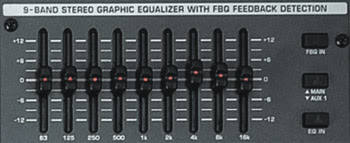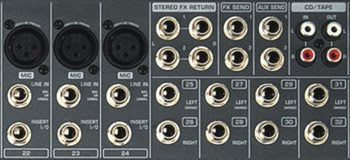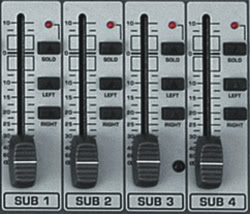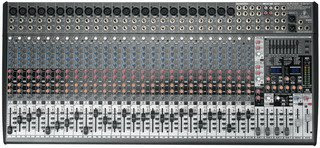 BEHRINGER - EURODESK SX3242FX
BEHRINGER - EURODESK SX3242FXThe EURODESK SX3242FX series is designed to meet the needs of studio and live mixing applications, with a comprehensive set of features that combine sonic excellence and a full complement of mixing & sound modification tools.
Each four-bus mixer features ultra-low noise, high-headroom XENYX microphone preamps. Mono input channels feature three-band, semi-parametric mid-range EQ with Neo-classic "British" response. Stereo input channels provide precise four-band equalization. Each input has four aux sends; with two sends switchable between pre/post fader, for a flexible mix of monitor and effects applications.
SX3242FX has two integrated effects processors and stereo 9-band graphic EQ. One-hundred 24-bit / 96kHz studio-quality effects presets can be called-up and assigned to one or both internal effects buses. Main or Monitor output EQ is set and fine-tuned with the intuitive FBQ Feedback Detection display.
When external signal processor is needed, the SX3242FX provides extensive insert patch-points for input channels and main outputs. The Master section offers a wealth of features such as multiple aux and stereo returns, switchable SIP / PFL monitoring, Talkback, metering and more.
An internal auto-ranging power supply (100 240V), gold-plated XLR output connectors and rugged steel construction ensure that the SX Series consoles will travel anywhere to tackle any recording or mixing task, with pristine audio quality and a minimum of external gear.
***
If you want classic analog handling but can't skimp on superior digital effects and studio-grade mic preamps, the SX3242FX is your new best friend. This mixer's 24 mic inputs, 8 stereo inputs and 4 buses give you enough leeway to handle anything from a graduation speech to a 5-piece band to a whole church service with praise band and choir.
 The XENYX Mic Preamp matches the sound quality, transparency, headroom and even the dynamic range of boutique-style, stand-alone mic preamps.
The XENYX Mic Preamp matches the sound quality, transparency, headroom and even the dynamic range of boutique-style, stand-alone mic preamps. Our neo-classic“British EQ”brings back the warmth and musicality of those ‘60s and ‘70s mega-console desks that made music history.
Our neo-classic“British EQ”brings back the warmth and musicality of those ‘60s and ‘70s mega-console desks that made music history. The XENYX FX mixers incorporate a new studio-grade 24-bit FX processor. Get 100 real-world and awesome effect presets at your fingertips.
The XENYX FX mixers incorporate a new studio-grade 24-bit FX processor. Get 100 real-world and awesome effect presets at your fingertips.Classic control, state-of-the-art sound
Each of the SX3242FX's 24 mic inputs connects to our world-famous, studio-grade XENYX mic preamps. They are legendary for their high headroom, warm natural timbre and utter lack of background noise. Plug in a large-diaphragm condenser mic and track a vocal to hear XENYX’s rich detail and spaciousness. Plug in a dynamic mic and stick it inside a bass drum to appreciate the whopping headroom.
You may experience side-FX…
 Whether you need to add a dab of reverb or delay to a live vocalist's mic or warp a hard day's studio session into psychedelic quicksand, the SX3242FX has you covered. We gave this mixer two independent studio-grade 24-bit stereo FX processors with 99 awesome presets (see full list below) to provide the perfect sonic garnish. “Sure they’re great for live sound, but I have a lot of cool plug-ins for recording,” we can hear some of you saying. Truth be told, you never have too many effects. And when you hear the quality of the SX3242FX’s FX, you may want to give your overworked CPU a rest.
Whether you need to add a dab of reverb or delay to a live vocalist's mic or warp a hard day's studio session into psychedelic quicksand, the SX3242FX has you covered. We gave this mixer two independent studio-grade 24-bit stereo FX processors with 99 awesome presets (see full list below) to provide the perfect sonic garnish. “Sure they’re great for live sound, but I have a lot of cool plug-ins for recording,” we can hear some of you saying. Truth be told, you never have too many effects. And when you hear the quality of the SX3242FX’s FX, you may want to give your overworked CPU a rest.Naturally we gave you a whole palette of creative effects like reverb, chorus, flanger, delay and pitch shifter tones, as well as mind-bending multi-effects to take your sound out of this world. But you also get problem solving workhorses like compression and gating plus final effects such as Ultramizer, Ultrabass and Exciter that can put a PA or studio mix over the top. And because there are two processors, you can cue two separate effects, then apply one or both to channels 1 through 28 — compression for the vocalist, reverb for the vocalist and snare drum, for example.
What the heck is “British EQ”?
A good thing to have on your side when you start reaching for those channel equalization knobs. At a live concert or in the studio.
Think of it as kinder, gentler, more musical EQ like the type found on classic British consoles from the 60’s and 70’s. Single malt scotch instead of Everclear. Home-baked cherry cobbler instead of an artificial cherry lollypop.
British EQ’s distinct configuration of wider curves/lower Q and harmonic phase characteristics allows you to add or subtract EQ more generously than you can with conventional EQ circuit designs. When you add low midrange, you get a firmer sound instead of a nasty bonk. When you back high frequencies off a bit, treble backs off just a hair instead of turning muffled.
All SX3242FX mono channels have low and high shelving plus a sweepable “midrange” you can move anywhere from 100Hz to 8kHz. Think of it as your roving English troubleshooter.
Kill feedback before it maims your audience.

When it comes to suppressing feedback, the SX3242FX is like having a bloodhound trained to spot trouble frequencies a mile away.
The 9-band graphic EQ (which you can choose to apply to your main mix or monitor mix via the MAIN/AUX1 button) features the FBQ Feedback Detection system. It makes finding and adjusting critical frequencies a snap. Just push FBQ IN, then watch as LEDs on the individual EQ sliders light up, indicating which frequency bands are causing feedback. Simply adjust until the LED goes dim.
The Ins and Outs

Some manufacturers make what they call 32-input mixers that count stuff like CD/TAPE IN as an input. But the SX3242FX really gives you twenty-four honest mono channels plus eight stereo channels, making it easy to accommodate a variety of studio or live performance configurations. You can connect up to 24 microphones or other mono instruments and up to four stereo instruments (keyboards or tone modules, for example).
You can combine these input in four different sub-mixes (we call them buses). That allows you to blend multiple channels—say all the mics on a drum kit or all the backup singers' mics—to a single fader, which is easier to adjust for the overall mix that goes to the PA speakers. You can also use one or more of the sub-mix buses to create custom monitor mixes for picky members of your band (“More me! More me!”).
A zillion ways to change the channel
 At the top of each mono channel, you'll find both a balanced XLR input with a XENYX mic preamp and a ¼" input. A phantom power switch located on the back near the main power switch accommodates condenser mics.
At the top of each mono channel, you'll find both a balanced XLR input with a XENYX mic preamp and a ¼" input. A phantom power switch located on the back near the main power switch accommodates condenser mics.Next comes is an insert for connecting up individual signal processors or feeding a remote broadcast feed or multitrack recorder directly.
Trim control and level set LED let you adjust the channel’s input level for maximum headroom and minimum noise — the huge range of this control can handle anything from a very timid vocalist to a close-miked guitar amp stack.
Each mono channel features a 3-band EQ with semi-parametric mids (giving you control of the Mid level and a sweepable frequency with a boost or cut of 15dB) and a Trim control for adjusting input gain via a Level Set LED.
A Low Cut button eliminates the frequencies where unwanted infrasonics such as mic handling, P-pops or wind noise occur.
FX1 and FX2 dials add a blend of up to two effects, and AUX1 and AUX2 dials help create your monitor mix. Press the PRE button to send a raw, EQ-free signal to the monitors. Near every mono channel's fader you'll find a 1-2, 3-4 and MAIN button. By engaging the MAIN button, the signal is sent to the main mix. Or, if you engage the 1-2 button, the channel becomes part of a bus. Twist the PAN control all the way to the left to assign it to Sub 1, or all the way to the right for Sub 2. The same principle applies to the 3-4 button.
A Mute button with accompanying LED cuts the signal from the channel, and a Clip LED helps you dial in a distortion-free post-EQ signal. The Solo button on individual channels routes the subgroup signal to the solo bus or Pre-Fader Listen—depending on whether the signal has been included in a subgroup.
Instead of XLR inputs, stereo channels 25-32 have left and right balanced/unbalanced line level inputs. Channels 25-28 feature the same controls as the mono channels, but with a four-band EQ that gives you control of HIGH, HIGH MID, LOW MID and LOW. This is especially useful for EQ'ing the critical midrange frequency content found in keyboard signals.
Stereo channels 29 through 32, designed for signals that do not require EQ, have a simplified interface consisting of a Level, AUX1 and AUX2 dial. Can you say laptop backing track feeds, drum machines, tone modules, DJ mixers or CD players?

Finally, all four sub-mix buses feature an independent fader (naturally), Solo switch with bright LED, and assign buttons for routing them to Left or Right stereo channels.
Packed with tasty details that make your creative life easier.
- We solved the problem of what to do when you want to play music during breaks but don’t want to have to mute every channel or turn down every fader. Just push CD/Tape STANDBY button to A) mute all mixer channels and B) solo just your CD/Tape source.
- We didn’t just give you a MONO output for subwoofers. We gave it a built-in variable low pass crossover, saving you money on outboard gear.
- We added a footswitch jack that you can use to control either internal or external effects.
- We gave you a complete Phones and Control Room assignment matrix so you can send mains, buses, CD/Tape or auxes out at the touch of a button.
- We added a routing button to Talkback so you can talk directly to either a monitor mix or the house mix for public announcements.
- We made the 9-band equalizer assignable to either AUX 1 or the main mix.
Take On The World
Not every town on the planet uses the same voltage common in yours. Unfortunately, this sometimes doesn't occur to jet-setting sound technicians until they're 5,000 miles from home. With the SX3242FX, this is never an issue. The internal autorange power supply can run on anything from 100 to 240 V with noise-free audio, top-quality transient response and low power consumption.
Teach your great grandkids how to run it.
BEHRINGER mixers last and last. We use top quality parts such as long-wear faders, sealed rotary controls and premium circuit boards. We have 20 years of experience figuring out how to compensate for clumsy load-ins, spilled drinks, crazed guitarists and millions of road miles. The result is a mixer you can count on day after day and night after night.
Why do you need this mixer?
- Built-in pristine XENYX mic preamps…LOTS of them
- Dual 24-bit FX processor with 99 presets including reverb, chorus, flanger, delay and pitch shifter tones
- British-style EQ dials give you the sound and control preferred by top studio engineers
- The built-in FBQ Feedback Detection system instantly reveals critical frequencies and the 9-band stereo graphic EQ allows precise correction of those frequencies in monitor or main mixes
- Awesomely complete I/O – everything from bus inserts to mono output
Finally, “And now for something completely similar.”
If you’ve read this and loved everything about the SX3242FX except it seemed like a bit too much mixer for your current needs, we have good news for you. It has a little brother, the SX2442! Sixteen mono channels each with superb XENYX mic preamps. And of course every other feature you’ve just read about. But in a smaller form factor and lower price. See both models at your BEHRINGER Dealer today.
EFFECT LIST
PARALLEL EFFECTS: | ||
|---|---|---|
| Cathedral (01-02) | --- | Very dense and long reverberation of a large cathedral |
| Plate (03-04) | --- | Simulates early plate reverb |
| Concert (05-06) | --- | Simulates a small theater or large concert hall |
| Stage (07-08) | --- | Very dense reverb, especially for live applications |
| Room (09-10) | --- | Simulates room's wall reverb. This particular room has two windows and yellow wallpaper |
| Studio (11-12) | --- | Adds spaciousness to the sound |
| Small Hall (13-14) | --- | Simulates hallway reverberation |
| Ambience (15-16) | --- | Simulates the reverb of a middle-sized room without late reflections |
| Early Reflections (17) | --- | Dense reverb with pronounced early reflections |
| Spring Reverb (19-20) | --- | Simulates spring reverb |
| Gated Reverb (21-22) | --- | Reverb that’s synthetically cut off |
| Reverse Reverb (23-24) | --- | Reverb that slowly gets louder |
| Chorus (25-30) | --- | Slight detuning of the original signal |
| Flanger (31-35) | --- | A delayed signal is added to the original signal, causing a phase shift |
| Phaser (36-39) | --- | Another phase-shift effect |
| Rotary Speaker (40-42) | --- | Simulation of a rotating electronic organ speaker |
| Delay (43-52) | --- | Delay of the input signal with repetitions |
| Chorus & Reverb (53-54) | --- | Combination of chorus and reverb |
| Flanger & Reverb (55-56) | --- | Flanger combined with reverb |
| Phaser & Reverb (57-58) | --- | Phaser combined with reverb |
| Rotary Speaker & Reverb (59-60) | --- | Rotary Speaker effect combined with Reverb |
| Delay & Reverb (61-63) | --- | Delay combined with Reverb |
| Delay & Chorus (64-67) | --- | Widens the signals and produces repetition effects |
| Delay & Flanger (68-70) | --- | Similar to Delay & Chorus, but with audible up/downward modulation |
INSERT EFFECTS: | ||
| Compressor (71-73) | --- | Soft or loud passages are raised or lowered in level respectively |
| Expander (74-76) | --- | Noise and hum is reduced in level |
| Gate (77-78) | --- | A gate opens for a specific period of time to make a specific signal pass, then closes abruptly |
| Ultramizer (79-80) | --- | Compression through automatic adaptation of compression parameters |
| Ultrabass (81-82) | --- | Combines sub-harmonics processor, bass exciter, and limiter |
| Panner (83-85) | --- | The signal "wanders" between the sides of the stereo basis |
| Exciter (86-88) | --- | Adds synthetic harmonics to the signal, resulting in increased presence and "loudness" |
| Auto Filter (89-91) | --- | Level-dependent boost of a specific frequency band, similar to auto-wah or electric guitars |
| Tube Distortion (92-93) | --- | Simulates the tube distortion of classic guitar amplifiers |
| Guitar Amp (94-97) | --- | Guitar amp simulation |
| Vinylizer (98) | --- | Adds the clicks and noise of old vinyl records |
| Test Tone (99) | --- | 1-kHz test tone. Virtually indistinguishable from some genres of techno. |
...



No comments:
Post a Comment